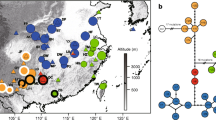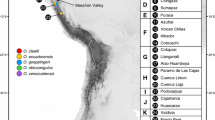Abstract
Helianthus petiolaris andH. niveus are polytypic species which are morphologically distinct at the periphery of their ranges but intergrade in areas of sympatry.Helianthus niveus includes both annual and perennial members, whereasH. petiolaris is strictly annual. Chloroplast DNA and nuclear ribosomal DNA restriction site data were used to reconstruct the evolutionary history of populations of the two species. Cladistic analyses reveal the following: (1) neither species is monophyletic; (2) the annual habit is derived once in this complex; and (3) the region of morphological intergradation appears to be primary in origin. The significance of interbreeding versus common descent in defining species concepts is discussed in relation to the above cladistic analyses.
Similar content being viewed by others
References
Avise, J., 1989: Gene trees and organismal histories: a phylogenetic approach to population biology. — Evolution43: 1192–1208.
—,Shapira, J., Daniel, S., Aquadro, C., Lansman, R., 1983: Mitochondrial DNA differentiation during the speciation process inPeromyscus. — Molec. Biol. Evol.1: 30–56.
Chandler, J., Jan, C., Beard, B., 1986: Chromosomal differentiation among the annualHelianthus species. — Syst. Bot.11: 354–371.
Cracraft, J., 1983: Species concepts and speciation analysis. — Curr. Ornith.1: 159–187.
—, 1989: Speciation and its ontology: the empirical consequences of alternative species concepts for understanding patterns and processes of differentiation. — InOtte, D., Endler, J., (Eds.): Speciation and its consequences, pp. 28–59. — Massachusetts: Sinauer Associates.
Debry, R., Slade, N., 1985: Cladistic analysis of restriction endonuclease cleavage maps within a maximum-likelihood framework. — Syst. Zool.34: 21–34.
De Queiroz, K., Donoghue, M., 1988: Phylogenetic systematics and the species problem. — Cladistics4: 317–338.
Doebley, J., 1989: Molecular evidence for a missing wild relative of maize and the introgression of its chloroplast genome intoZea perennis. — Evolution43: 1555–1558.
Donoghue, M., 1985: A critique of the biological species concepts and recommendations for a phylogenetic alternative. — Bryologist88: 172–181.
Doyle, J. J., Doyle, J. L., 1987: A rapid DNA isolation procedure for small amounts of fresh leaf tissue. — Phytochem. Bull.19: 11–15.
Felsenstein, J., 1979: Alternative methods of phylogenetic inference and their interrelationship. — Syst. Zool.28: 49–62.
Ghiselin, M., 1987: Species concepts, individuality, and objectivity. — Biol. Phil.2: 127–143.
Hauser, C., 1987: The debate about the biological species concepts—a review. — Z. Zool. Syst. Evolut.-forsch.25: 241–257.
Heiser, C., 1961: Morphological and cytological variation inHelianthus petiolaris with notes on related species. — Evolution15: 247–258.
—, 1973: Introgression re-examined. — Bot. Rev.39: 347–366.
—,Smith, D., Clevenger, S., Martin, W., 1969: The north american sunflowers (Helianthus). — Mem. Torrey Bot. Club22: 1–218.
Levin, D., 1979: The nature of plant species. — Science204: 381–384.
Lidén, M., Oxelman, B., 1989: Species—pattern or process? — Taxon38: 228–232.
Mishler, B., Brandon, R., 1987: Individuality, pluralism, and the phylogenetic species concept. — Biol. Phil.2: 397–414.
—,Budd, A., 1990: Species and evolution in clonal organisms—introduction. — Syst. Bot.15: 79–85.
—,Donoghue, M., 1982: Species concepts: a case for pluralism. — Syst. Zool.31: 491–503.
Murray, J., 1972: Genetic diversity and natural selection. — Edinburgh: Oliver & Boyd.
Nei, M., Li, W., 1979: Mathematical model for studying genetic variation in terms of restriction endonucleases. — Proc. Natl. Acad. Sci. U.S.A.76: 5269–5273.
Nelson, G., 1989: Cladistics and evolutionary models. — Cladistics5: 275–289.
Palmer, J., 1986: Isolation and structural analysis of chloroplast DNA. — InWeissbach, A., Weissbach, H., (Eds.): Method in enzymology, pp. 167–186. — New York: Academic Press.
Paterson, H., 1985: The recognition concept of species. — InVrba, E., (Ed.): Species and speciation, pp. 21–29. — Pretoria: Transvaal Museum.
Ridley, M., 1989: The cladistic solution to the species problem. — Biol. Phil.4: 1–16.
Rieseberg, L., Soltis, D., Palmer, J., 1988: A molecular re-examination of introgression betweenHelianthus annuus andH. bolanderi (Compositae). — Evolution42: 227–238.
—,Beckstrom-Sternberg, S., Doan, K., 1990:Helianthus annuus subsp.texanus has chloroplast DNA and nuclear ribosomal RNA genes ofHelianthus debilis subsp.cucumerifolius. — Proc. Natl. Acad. Sci. U.S.A.87: 593–597.
- -Liston, A., Arias, D., 1991: Phylogenetic and systematic inferences from chloroplast DNA and isozyme variation inHelianthus sectionHelianthus (Asteraceae). — Syst. Bot. (in press).
Schilling, E., Heiser, C., 1981: Infrageneric classification ofHelianthus (Compositae). — Taxon30: 393–403.
Soltis, D., Soltis, P., Milligan, B., 1990: Intraspecific chloroplast DNA variation. — InSoltis, D., Soltis, P., Doyle, J., (Eds.): Plant molecular systematics. — New York: Chapman & Hall (in press).
Templeton, A., 1981: Mechanisms of speciation. — A population genetic approach. — Annu. Rev. Ecol. Syst.12: 33–48.
—, 1989: The meaning of species and speciation: a genetic perspective. — InOtte, D., Endler, J., (Eds.): Speciation and its consequences, pp. 3–27. — Massachusetts: Sinauer Associates.
Van Valen, L., 1982: Integration of species: stasis and biogeography. — Evol. Theory6: 99–112.
Wheeler, Q., Nixon, K., 1990: Another way of looking at the species problem: a reply tode Queiroz andDonoghue. — Cladistics6: 77–82.
White, M., 1978: Modes of speciation. — San Francisco: Freeman.
Wolfe, P., Soltis, D., Soltis, P., 1990: Chloroplast-DNA and allozymic variation in diploid and autotetraploidHeuchera grossulariifolia (Saxifragaceae). — Amer. J. Bot.77: 232–244.
Author information
Authors and Affiliations
Rights and permissions
About this article
Cite this article
Beckstrom-Sternberg, S.M., Rieseberg, L.H. & Doan, K. Gene lineage analysis in populations ofHelianthus niveus andH. petiolaris (Asteraceae). Pl Syst Evol 175, 125–138 (1991). https://doi.org/10.1007/BF00937842
Received:
Accepted:
Issue Date:
DOI: https://doi.org/10.1007/BF00937842




